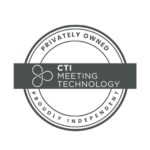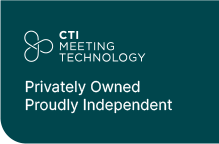Hybrid events have quickly become the preferred format for many organizers who see opportunities to increase attendance without inflating their budgets. For organizers, the value is clear: you can dramatically increase attendance with a minimal increase in resources. For attendees, the power is in their hands. They have the flexibility to participate in person or virtually, from anywhere on the planet. This is the ultimate expression of inclusivity: giving every attendee a seat at the table, regardless of their physical location. This is the true promise of a successful hybrid event.
However, as any event professional will tell you, translating this promise into reality is a considerable challenge. The struggle lies in finding a single cohesive platform that can manage the complexities of both in-person and virtual audiences without making you feel like you’re running two separate events. This fragmented approach, with one tool for registration, another for streaming, and yet another for networking, leads to disjointed experiences, significant logistical hurdles, and a missed opportunity to collect unified, meaningful data.
Choosing the Right Technology
Choosing the right technology is vital; your event management platform is the backbone of your entire event, directly influencing everything from attendee satisfaction to the long-term viability of your meetings. A powerful, all-in-one platform is essential for several key reasons:
- Better Engagement: A unified system provides a consistent and interactive experience for both in-person and virtual attendees, ensuring everyone feels connected and involved.
- A Unified Audience Experience: By breaking down the barrier between onsite and online, you can create a cohesive community where all participants can interact and network seamlessly.
- Increased Efficiency: A single, integrated dashboard streamlines logistics, registration, and communication, saving you countless hours of administrative work.
- Enhanced Flexibility: The right platform empowers you to easily adapt your event format and content, offering on-demand sessions and personalized schedules that cater to individual needs.
- Inclusivity: By providing global accessibility and support for diverse audiences, you can attract a wide range of participants and provide a more equitable space.
To help you navigate the ever-evolving event industry and select a reliable and scalable platform for your meetings in 2026, we have grouped the essential features you must look for. This guide will provide you with the insight you need to build a robust tech stack for hybrid events that meets the demands of a modern audience.
Top Features for Hybrid Meetings
Selecting the right platform is the single most important decision you will make for your hybrid meeting. We’ve listed twelve essential features of a modern event management system that will empower you to deliver a seamless, impactful, and data-driven experience for every participant.
1. Integrated Management for Virtual and In-Person Components
The biggest challenge of managing hybrid meetings is avoiding the feeling that you are running two separate events. All too often, organizers find themselves juggling a web of separate tools: one for in-person registration, another for virtual attendees, a third for content, and a fourth for data. This fragmented approach is not only inefficient but creates a disjointed experience for your audience. The solution? A platform built from the ground up to handle both in-person and virtual components from a single, unified dashboard.
Ideally, all of your event information should be centralized in one system. This means that every aspect of your meeting, from registration and abstract submissions to session management and real-time analytics, lives within the same space. Last-minute changes to a session, speaker bios, or room updates are synced automatically across the virtual platform, the mobile app, and the event calendar, ensuring a single source of truth for everyone.
An all-in-one platform provides the foundational pillar for a streamlined workflow. While some solutions, like cOASIS, are designed to be comprehensive, it’s also crucial to consider a platform’s scalability. As your meetings grow in size and complexity, you may need to integrate with other best-in-class third-party providers. A truly modern platform should feature modular architecture with robust API integration capabilities, allowing you to build the ideal tech stack for hybrid events that meets your unique needs without being locked into a single vendor.
2. Flexible Agenda and Session Design Tools
In a hybrid world, one size does not fit all. In-person and remote attendees have different needs and habits when it comes to consuming content. An onsite participant might want to build a personalized itinerary to navigate the physical venue, while a virtual attendee might prefer to create a schedule that respects their time zone or allows them to watch a session on demand.
This is where a flexible agenda builder becomes an indispensable tool. A platform that allows you to create customizable, track-based schedules with overlapping sessions empowers every attendee to design their own personalized journey. While offering on-demand content is not mandatory, the flexibility it provides is a game-changer. Not only does it break down time-difference barriers for your global audience, but it also allows in-person attendees to revisit key talks or catch sessions they missed. This flexibility is a direct driver of successfully managing in-person and online attendees, leading to a more satisfied and engaged audience overall.
Crucially, make sure your chosen platform instantly syncs any last-minute scheduling changes or updates across all platforms and devices, from the web portal to the mobile app, to prevent scheduling conflicts and attendee frustration.
3. Advanced Audience Engagement Features
It’s a common misconception that keeping a virtual audience engaged is harder than an in-person one. The real challenge, however, is creating a unified, shared experience where both groups can participate and interact together. It’s about bridging the gap between the room and the screen.
The right hybrid conference tools make this not only possible but effortless. Look for a platform that offers a suite of intuitive, user-friendly engagement features that work seamlessly for both virtual and onsite participants.
Essential event engagement tools 2026 include:
- Live Chats and Q&A: An integrated chat function enables attendees to ask questions and share comments in real time, giving speakers instant feedback and making the audience feel more included.
- Interactive Polls and Surveys: These tools are fun and easy ways to gather immediate feedback, spark discussion, and break up long sessions.
- Networking Lounges and Community Boards: These spaces serve as the digital equivalent of a hallway conversation, encouraging spontaneous interactions and allowing attendees to connect outside of formal sessions.
- Gamification: By adding elements of friendly competition, such as leaderboards and challenges, you can motivate attendees to engage more deeply with content and networking opportunities.
By using these tools, you can ensure that your in-person and virtual attendees aren’t just observers, but active participants in a vibrant community.
4. AI-Powered Matchmaking Tools
Networking is a main driver of attendance for many professional and academic meetings. Yet, the traditional method of finding the right people in a crowded room is often left to chance. The most sophisticated top event platforms for science meetings and other gatherings leverage the power of AI in hybrid event platforms to create a more efficient and valuable networking experience.
AI-powered matchmaking tools analyze attendee profiles, interests, and stated goals to intelligently connect participants with the people, sessions, and content most relevant to them, going far beyond a simple list of attendees.
These tools provide smart recommendations for one-on-one meetings, suggest relevant sessions to attend, and can even facilitate connections between researchers, speakers, and potential collaborators. This level of personalized discovery makes networking more purposeful and impactful, giving every attendee a higher return on their time and effort.
5. High-Quality Streaming and On-Demand Access
For your virtual attendees, the streaming experience is the entire event. There is nothing more frustrating than trying to engage with a talk that is constantly buffering, pixelated, or suffering from dropped audio. Delivering high-quality, reliable video streaming is a non-negotiable feature for any modern hybrid platform. It’s the single most important factor for virtual attendee satisfaction.
Furthermore, a top-tier platform will offer more than just a live stream. It will have a robust content library for on-demand access. Capturing all live sessions and making them available for replay significantly extends the life of your event and its content. This feature allows attendees to:
- Catch up on sessions they missed due to scheduling conflicts.
- Revisit key presentations to reinforce their learning.
- Engage with content at a time that is convenient for them, especially across different time zones.
- For science and research-focused events, it also creates a valuable, searchable archive for years to come.
As a bonus, look for platforms that offer built-in live captions and translations. The cOASIS platform, for example, offers live captions in over 29 languages, ensuring your content is accessible to a global audience and making sessions searchable by keyword so attendees can find information faster.
6. Mobile App Integration for All Participants
In a hybrid event, the mobile app serves as the central command center for every attendee. It provides a cohesive and seamless experience whether they are navigating a physical venue or engaging from their home office. A fully integrated event app is now an expectation, not a luxury.
The app should sync in real time with the main event platform, providing attendees with:
- Personalized Itineraries: A digital agenda that is always up-to-date.
- Push Notifications: Real-time alerts for session changes, networking opportunities, or speaker updates.
- Interactive Maps: For in-person attendees, this is a lifesaver for finding sessions, booths, and key locations.
- Networking and Content Access: A single point of access to speaker bios, presentation materials, and the networking tools mentioned earlier.
7. Real-Time Post-Event Analytics
Data is the lifeblood of a successful event strategy. Without it, you are left to make decisions based on guesswork. A key benefit of using a fully integrated event management software is the ability to track comprehensive, real-time analytics from a single dashboard.
A modern platform provides a detailed overview of your event performance, including:
- Attendance and Engagement Metrics: Track who attended which sessions, how long they stayed, and their level of interaction with polls and Q&A.
- Content Consumption: Analyze which sessions and on-demand videos were the most popular.
- Networking Activity: See which networking tools were most used and how many connections were made.
- Sponsor ROI: Track engagement with sponsor content and virtual booths.
8. Secure Registration and Data Privacy Controls
In an era of increased digital security awareness, the trust of your attendees is paramount. A modern hybrid event platform must prioritize robust security and data privacy. With a global audience, compliance with regulations like GDPR is not optional; it is a fundamental requirement.
When evaluating platforms, ask critical questions about their security measures. Look for features such as:
- GDPR Compliance: The platform should have clear consent tracking mechanisms and data management practices that align with global regulations.
- Secure Cloud Infrastructure: Your event data—from attendee profiles to payment information—must be hosted on a secure, encrypted, and reliable cloud network.
- Single Sign-On (SSO): SSO provides a secure and seamless login experience for your attendees while adding an extra layer of protection.
- Data Control: The platform should provide full control over who can access and manage attendee data, from both a user and administrator perspective.
A platform that adheres to these standards demonstrates a commitment to building a trustworthy environment.
9. Exhibitor and Sponsor Tools
A hybrid format offers your exhibitors and sponsors an unprecedented opportunity to engage with both a physical and a global virtual audience, but only if the platform provides the right tools to facilitate that.
A great hybrid platform will empower your partners with:
- Customizable Virtual Booths: More than just a static page, these booths should be interactive, allowing for live chat, video meetings, and downloadable resources.
- Branding Opportunities: Create dynamic spaces for sponsor logos, video advertisements, and sponsored sessions for maximum visibility.
- Integrated Lead Retrieval: In person, you can accomplish this with a simple badge scan. Virtually, you need to automatically capture data from booth visitors and direct interactions, providing a clear pathway for follow-up.
- Real-time Sponsor Dashboards: To prove ROI, sponsors need to see real-time data on traffic, leads, and engagement with their content.
By providing these tools, you transform your hybrid event into a valuable, measurable platform for your sponsors, ensuring a “win-win” partnership.
10. Customization and Branding Flexibility
Your event is an extension of your brand, and the platform that hosts it should reflect that. The ability to fully customize the visual identity and user experience is crucial for building a professional, high-quality event. Customization goes far beyond simply adding a logo.
A modern platform should allow you to:
- Control the Visual Identity: Match the platform’s colors, fonts, and design elements to your brand guidelines.
- Tailor the User Experience: Customize the layout and modules to best suit your audience and event type, ensuring that attendees can easily find what they need.
- Create a Unique Journey: Design distinct attendee paths for different types of participants, from general attendees to speakers and sponsors.
This level of platform scalability and customization ensures your event feels cohesive and professional.
11. Multilingual and Accessibility Support
As we’ve discussed, a core value of hybrid events is inclusivity. In 2026, this must extend to language and accessibility. It is a must, not a nice-to-have feature. Look for a platform with built-in support for:
- Multilingual Interfaces: A user interface that can be easily translated into the native languages of your global attendees.
- Live Captioning and Translation: This feature is essential for attendees with hearing disorders and for making your content accessible to a broader, non-native English-speaking audience.
- Accessibility Standards: The platform should be designed with accessibility in mind, adhering to standards such as WCAG to ensure a positive experience for people with disabilities.
12. Future-Proofing your Event Tech Stack
The technology landscape is constantly evolving. The platform you choose today must be able to adapt to tomorrow’s innovations. This requires a long-term, strategic approach to your tech stack for hybrid events.
The key to future-proofing is selecting a flexible platform with robust API integration capabilities. This allows you to:
- Connect New Tools: Easily integrate with new software, from AI-powered personalization tools to advanced marketing automation platforms.
- Scale with Confidence: As your event grows, the platform can handle increasing numbers of attendees and complex demands without performance issues.
- Build a Custom Solution: You are not limited to a single, monolithic product. Instead, you can build a customizable solution tailored to your exact needs.
Ready to Go Hybrid?
As we have explored, the ideal platform must go far beyond simple video streaming. It must provide a single source of truth for all your data, a flexible agenda that respects the unique needs of every attendee, whether in-person or virtual, and a powerful suite of event engagement tools. The right choice empowers you to streamline operations, prove value with comprehensive event analytics, and future-proof your meetings against an ever-evolving digital landscape.
This comprehensive approach is the basis of cOASIS. We’ve built a platform that brings all these essential features together, seamlessly integrating every aspect of your event from registration to post-event reporting. With cOASIS, you get a single, intuitive system that not only meets the demands of today’s attendees but is also equipped with the platform scalability and customization needed to support your events for years to come. Explore the platform today!





